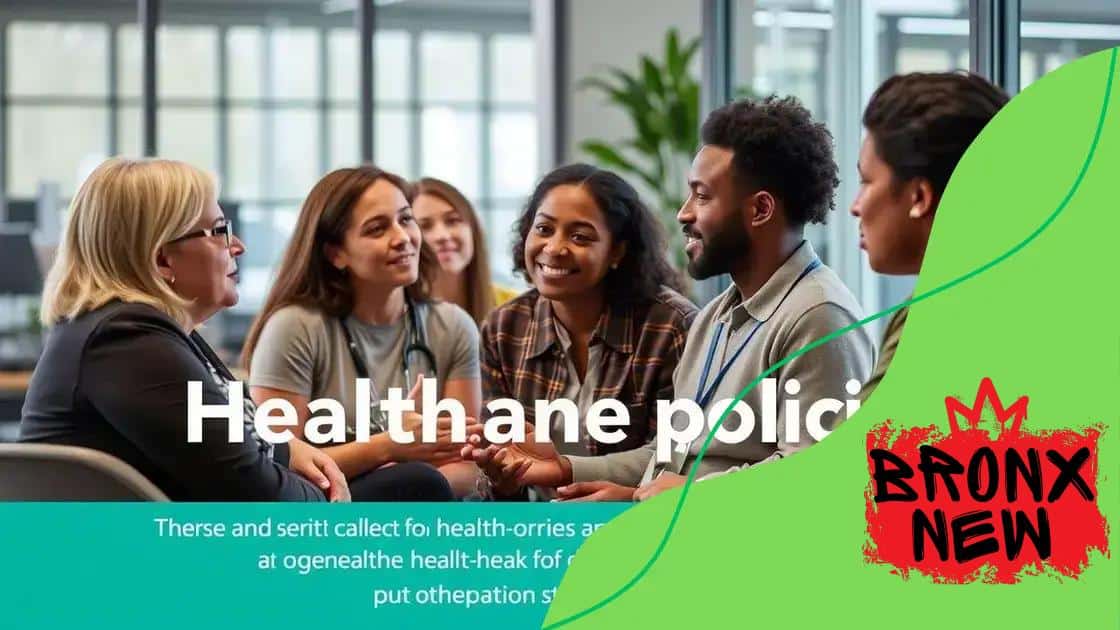The future of Medicaid expansion under new legislation

The future of Medicaid expansion under new legislation promises to enhance healthcare access for low-income individuals, addresses funding challenges, and encourages the integration of alternative healthcare solutions to improve overall community health.
The future of Medicaid expansion under new legislation is at a crossroads, influencing healthcare access across the nation. Have you thought about how these changes might affect you or someone you know?
Understanding Medicaid expansion
Understanding Medicaid expansion is crucial for grasping how healthcare accessibility can change for many Americans. This program aims to provide health coverage for low-income individuals, helping them access essential medical services and support.
When states opt for Medicaid expansion, they open the door to additional federal funding. This funding can improve healthcare systems and support local economies by providing jobs and resources. Understanding these benefits is key to evaluating the effectiveness of the program.
Key Benefits of Medicaid Expansion
There are several significant advantages of expanding Medicaid. These include:
- Increased access to healthcare for low-income populations.
- Decreased rates of uninsured individuals in participating states.
- Improved health outcomes, particularly for chronic conditions.
- Economic growth through job creation in the healthcare sector.
Many believe that Medicaid expansion can lead to better community health. However, it also raises questions about state budgets and long-term sustainability. Balancing these factors is important for lawmakers and constituents alike.
Challenges to Medicaid Expansion
While there are numerous benefits, there are also challenges. Some states hesitate to expand due to concerns about costs and the impact on their budgets. These financial worries can be complicated by changing political landscapes, where the nature of support for Medicaid can shift rapidly.
Additionally, the complexity of healthcare policies makes it hard for some people to understand their rights and benefits under Medicaid. Education and advocacy play vital roles in navigating these waters.
Understanding Medicaid expansion requires attention to the details and ongoing discussions about healthcare policy. By grasping these concepts, individuals can make more informed decisions about their health and advocate for policies that promote better access for all.
Key changes in the new legislation
The key changes in the new legislation surrounding Medicaid expansion are making headlines and affecting millions. Understanding these changes is essential for patients, providers, and lawmakers alike.
One of the most significant aspects of the new legislation is the increase in federal funding available to states that choose to expand Medicaid. This funding is critical as it helps cover a larger portion of the costs, reducing the burden on state budgets while ensuring more people receive necessary medical care. It offers a chance for states to improve their healthcare systems.
Major Changes to Eligibility
Eligibility criteria are also evolving under the new rules. These changes aim to provide healthcare access to additional groups of people, including:
- Low-income individuals and families who previously did not qualify.
- Working adults who may face barriers to accessing traditional coverage.
- Individuals facing unemployment due to economic shifts.
- People with chronic health conditions requiring regular treatment.
This broadened eligibility can result in a substantial drop in the uninsured rate. It represents a step toward more equitable healthcare access, especially in underserved communities.
Enhanced Benefits and Services
In addition to eligibility expansions, the legislation is set to enhance benefits and services provided to Medicaid recipients. These enhancements can include:
- Expanded mental health services to address growing needs.
- Access to preventive care, allowing individuals to seek treatment before issues escalate.
- Increased coverage for telehealth services, especially important during times of social distancing.
- Support for substance abuse treatment programs.
As these improvements roll out, recipients can expect more comprehensive care tailored to their unique needs. These changes are designed to improve overall health outcomes and decrease long-term healthcare costs.
Overall, the new legislation reflects a commitment to improving the Medicaid program for those who rely on it most. Continued monitoring and adjustments will be necessary to ensure the intended impacts are achieved.
Potential impact on low-income individuals

The potential impact on low-income individuals from the recent Medicaid expansion is profound. These changes aim to provide better healthcare access and improve overall quality of life for vulnerable populations.
For many low-income individuals, Medicaid expansion can mean the difference between living without essential health services and receiving the care they need. By broadening eligibility, more individuals can obtain coverage. This leads to a decrease in the number of uninsured, which is a critical step in addressing healthcare disparities.
Access to Essential Services
One of the most immediate effects of Medicaid expansion is increased access to essential medical services. Low-income individuals can look forward to:
- Routine check-ups and preventive care, which keep health issues manageable.
- Access to specialists, ensuring timely treatment for chronic diseases.
- Mental health services, helping to address emotional and psychological well-being.
- Prescriptions and medications that were previously unaffordable.
This access is vital for maintaining a healthy lifestyle and can significantly contribute to better long-term health outcomes.
Economic Stability
Beyond healthcare access, Medicaid expansion can also lead to greater economic stability for low-income individuals. With reliable healthcare coverage, people are less likely to face financial hardships due to unexpected medical expenses. Furthermore, healthier individuals tend to be more productive at work, contributing positively to the economy.
The expansion can also relieve some financial stress from emergency rooms. When individuals can access care before issues escalate, it reduces long-term costs associated with advanced treatments. This proactive approach not only benefits patients but also alleviates pressure on healthcare systems as a whole.
This change in policy, by focusing on the needs of low-income individuals, represents a step toward a healthier, more equitable society that values everyone’s right to quality healthcare. The implications are significant, as this can foster community growth and prosperity, enabling individuals to lead healthier and more fulfilling lives.
Challenges ahead for Medicaid expansion
The challenges ahead for Medicaid expansion are multifaceted and require careful navigation. As states consider or implement expansion, they face various barriers that can affect the success of the program.
One major challenge is the political landscape. Not all states support Medicaid expansion, and shifting political priorities can lead to uncertainty. Some lawmakers worry about the long-term costs associated with new enrollees and may resist efforts to expand coverage.
Funding Concerns
Funding is another critical issue. Even though the federal government provides significant financial support, states still have to cover a portion of the costs. This can strain already tight budgets, especially when economic conditions fluctuate. The fear of budget overruns can prevent states from committing to expansion.
In addition, managing funds wisely is essential to ensure quality care. States must balance delivering comprehensive benefits while controlling expenditures, which can be a complex puzzle.
Outreach and Education
Another challenge is the need for effective outreach and education. Many eligible individuals may not know they qualify for Medicaid expansion. This gap can lead to lower enrollment rates than expected. States need to engage in robust marketing and community outreach programs to raise awareness about available services.
Ensuring that potential beneficiaries understand the enrollment process is equally important. Simplifying the application process can help individuals access care without barriers, but this requires significant investment in resources and knowledge sharing.
Lastly, states may face logistical issues. Expanding coverage involves integrating new enrollees into existing healthcare systems. This influx can create strain on hospitals and clinics, particularly those already serving low-income populations. Ensuring that there are enough providers to meet the increased demand is necessary to maintain quality care.
Exploring alternative healthcare solutions
Exploring alternative healthcare solutions is becoming increasingly important as the landscape of healthcare evolves. With rising costs and access issues, many individuals seek new ways to maintain their health. These alternatives can offer different approaches to care that complement or enhance traditional methods.
Among these solutions, integrating holistic practices is gaining attention. Holistic medicine considers the whole person—body, mind, and spirit—when treating ailments. This approach often includes therapies such as:
- Acupuncture, which can help relieve pain and stress.
- Chiropractic care, focusing on the alignment of bones and joints.
- Massage therapy, promoting relaxation and reducing muscle tension.
- Nutritional counseling, emphasizing the importance of diet in health.
These methods can provide individuals with tools to manage their health proactively. Many find that integrating these services helps address chronic conditions more effectively than traditional methods alone.
Telehealth Services
Additionally, telehealth has become a vital alternative. It allows patients to connect with healthcare providers remotely, which is especially beneficial for those who face barriers to accessing in-person care. Telehealth can involve:
- Virtual consultations that save time and travel costs.
- Remote monitoring of chronic conditions, enhancing patient engagement.
- Access to specialists who may not be available locally.
- Follow-up care that reduces the need for physical visits.
This option enhances flexibility and can lead to high satisfaction rates among users. As technology improves, telehealth solutions will likely become even more integrated into conventional healthcare practices.
Lastly, community health programs play a significant role in providing alternative solutions. These programs often focus on preventive care and education, specifically tailored to the needs of local populations. They can address issues such as:
- Chronic disease management through workshops.
- Mental health support through localized outreach.
- Wellness initiatives promoting healthy lifestyle choices.
By fostering a strong community connection, these programs empower individuals to take charge of their health. Overall, as we explore alternative healthcare solutions, we see an increasing emphasis on personalized and accessible care options that can complement traditional healthcare pathways.
FAQ – Frequently Asked Questions about Medicaid Expansion
What is Medicaid expansion?
Medicaid expansion is the process of broadening eligibility for Medicaid to cover more low-income individuals, ensuring they have access to essential health services.
What are the benefits of Medicaid expansion for low-income individuals?
The benefits include increased access to healthcare, routine check-ups, and mental health services, which help improve overall health outcomes.
What challenges do states face when implementing Medicaid expansion?
States may face funding concerns, political resistance, and the need for effective outreach to inform eligible individuals about the program.
How do alternative healthcare solutions complement traditional Medicaid services?
Alternative solutions like telehealth and holistic practices enhance patient care by providing more options, improving access, and addressing diverse health needs.





